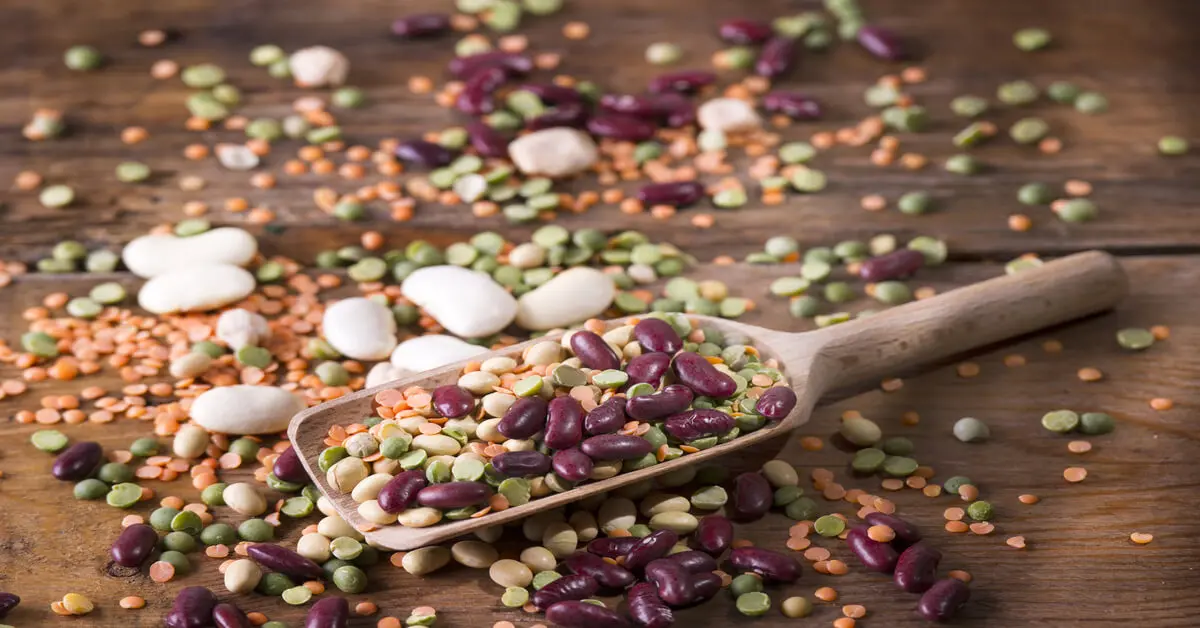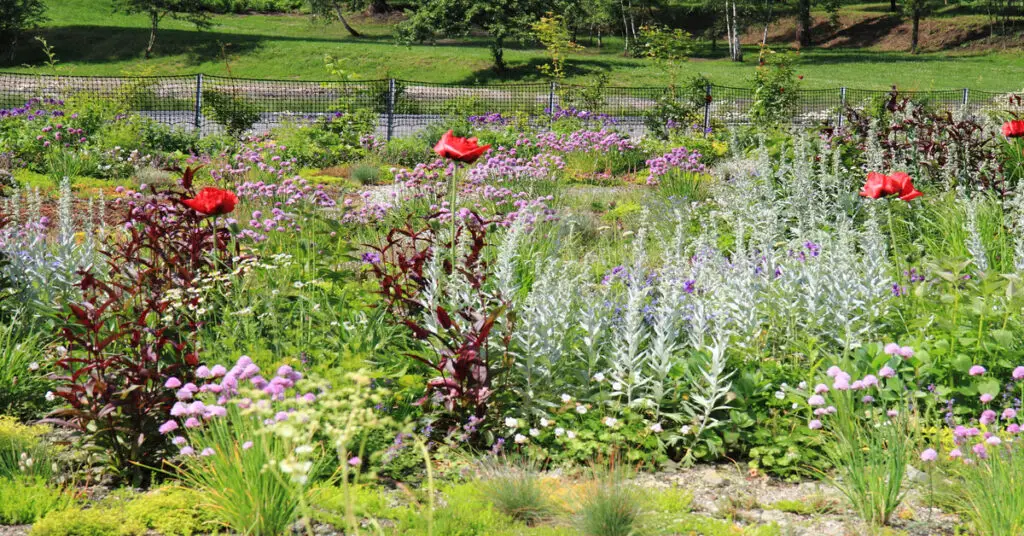Chaos gardening is a great way to create an affordable, low-maintenance garden. They provide a variety of ecological benefits to the garden and allow you to finally use leftover seeds you’ve collected. To be successful with chaos gardening, you have to be willing to step back and let mother nature do its thing.
You can use wildflowers, herbs, vegetables, or a combination of all three in a chaotic garden. There really aren’t any rules when it comes to what you plant in your chaos garden. As long as you have a diversity of plant seeds, you’ve met the only requirement of chaos gardening.
In this guide, we’ll tell you all about what chaos gardening is and how you can implement it. We’ve got a step-by-step guide for planting the garden and different ways you can choose your seeds. We’ll also go over the top three benefits that chaotic gardens provide.
What Is Chaos Gardening?

Chaos gardening means planting your seeds without any particular placement or arrangement. You mix together a variety of seeds and scatter them across your garden. You then wait to see what comes up naturally and work with what you get.
Many gardeners use this approach when they have a bunch of unused seeds they want to use. It’s also considered to be a great approach for lazy gardening.
Chaos gardening makes planting a garden a quick and easy process. You won’t be spending hours planning and sowing the garden. Throw out a mixture of seeds and then sit back and see what happens.
Once the plants start to emerge, you may want to thin them out a bit to allow space for healthy growth. However, this isn’t a required step. You can simply let nature run its course and let the plants fight it out amongst themselves.
Chaos gardening is also considered to be a budget-friendly gardening option. Seeds are much cheaper than purchasing seedlings. If you already have a bunch of unused seeds on hand, you won’t have to spend anything on garden plants.
Planting A Chaos Garden

When it comes to chaotic gardening, there are a few steps you should follow. This will ensure you aren’t left with a garden plot that has nothing growing in it.
Make sure you don’t plant your seeds until two weeks after the predicted last frost date in your area. This will ensure your seeds don’t start germinating just to be killed back by frost.
Here are the steps to follow to plant a successful chaos garden.
-
Select a space for your garden. You can choose an empty spot in your yard or use a raised bed.
-
Prep the soil for your garden. While you don’t have to do any soil prep, it will increase the chances of success.
Remove any weeds or old plants from the area. Add some compost to the area to provide fertilizer and organic matter for plant growth. Rake in the compost and spread the soil out evenly over the area.
-
Next, gather your seeds. If you’re not sure what seeds to use, check out the section below for inspiration.
-
Soak seeds overnight in a bowl of water. This will give them the best chance possible of germinating.
-
Use a coffee filter or paper towel to strain the smaller seeds from the water. Place the seeds in a large bowl and mix in about a cup of soil. The soil will help make it easier to spread the seeds out in your garden.
-
Spread your chaos garden seed mix evenly across your garden space. If the space is large, you may want to leave an empty aisle down the middle. This will give you room to do any pruning, weeding, or harvesting if you choose.
All that’s left to do is sit back and see what grows in your chaotic garden!
The beauty of chaos gardening is there’s not really a right or wrong way to do it. You can take a fully hands-off approach to your chaos garden and let it mature as it will on its own. If you prefer to get your hands dirty, feel free to pull weeds or thin out seedlings to improve plant growth.
Chaos Garden Seed Mix

There are a few different ways to go about creating your chaos garden seed mix. Some people will only use seeds that they’ve collected that are past their prime. Others will purchase seeds for plants they want but use chaos gardening as a quicker way to plant them.
Here are a few different ways you can approach making your seed mix for your chaos garden.
-
Mix all of your seeds that are more than 2 or 3 years old together. Many seeds have reduced germination rates after a few years. Instead of throwing them out, you can mix them together and use them in a chaos garden.
-
If you want to grow a chaos vegetable garden, mix a variety of vegetable seeds together. You may want to avoid using many vining or trailing plants which may overcrowd the space. Creating a scatter vegetable garden will help maximize your garden space.
We recommend that you add a few pollinator-friendly plants to the mix like cosmos or black-eyed Susans. Especially if you’re growing plants that require insect pollination like tomatoes. This will encourage pollinators in the garden and help ensure you get good yields from your garden.
-
If you don’t have a collection of old seeds, you can find mixed seed packets online. Many only cost 5 to 10 dollars. You can get a mix of flowers, herbs, veggies, or all three to use for chaos gardening.
-
Use seed bombs to plant your chaos garden. Seed bombs are a mixture of seeds, soil, clay, and sometimes paper
[2]. You throw them on the ground and allow them to germinate.
You can make your own seed bombs or purchase them. This is a great option if you don’t want to do any soil prep for your chaotic garden. The seed bombs contain enough soil to allow the seeds to germinate with no effort from you.

Chaos Gardening Benefits
Biodiversity is a major benefit of chaos gardening. If you look at a natural space like a meadow or forest, you’ll see a wide diversity of plants. Having plant diversity provides a variety of natural benefits to a space[1].
Having fewer plant species in an area tends to increase the number of pest issues you deal with. When plants are more diverse, you’ll have a larger variety of insect predators and parasites. Having more insect pest predators and parasites leads to having few insect pests in your garden.
Having a biodiverse garden can also allow your plants to grow better[1]. For example, different plants rely on different soil nutrients at different times. A chaotic garden creates less competition among plants for soil nutrients and can improve soil health.
Affordability is another benefit of chaos gardening. Whether you use seeds you already have on hand or purchase them you’ll save money. Growing plants from seeds will cost a tiny fraction of the price of buying seedlings.
Having a biodiverse garden will save you money because it helps naturally reduce pest and soil issues. You won’t spend as much money on soil amendments or pesticides when you use chaos gardening.
As the saying goes, time is money. Chaos gardens are a low-maintenance alternative to traditional gardening. Even if you decide to do some work to your chaos garden, it won’t need nearly as much input as a normal garden.
You’ll also save time when it comes to planting your chaos garden. No need to spend hours picking plants and planning out exactly where to place each one. You also won’t have to spend time carefully planting each seed in the garden, just scatter them about.
Chaos Gardening vs Guerrilla Gardening
The main difference between chaos gardening and guerrilla gardening is land ownership. Chaos gardening is typically done on land you own or have permission to garden on. Guerrilla gardening is done on unkept public or private property that you don’t own.
However, chaos gardening can be a great approach to use for guerrilla gardening. You usually can’t do much site prep or maintenance when guerrilla gardening. Sometimes all you can do is plant a mixture of seeds and hope for the best.
Both chaos and guerrilla gardening rely heavily on letting nature run its course. This can result in beautiful spaces that look natural.
References
[1] Castro, D.C. (2020). A gentle plea for chaos in the garden. University of Florida, IFAS Extension.
[2] Griffith, B. (2022).
Make Your Own Wildflower Seed Bombs. North Illinois University, NIU STEAM.
